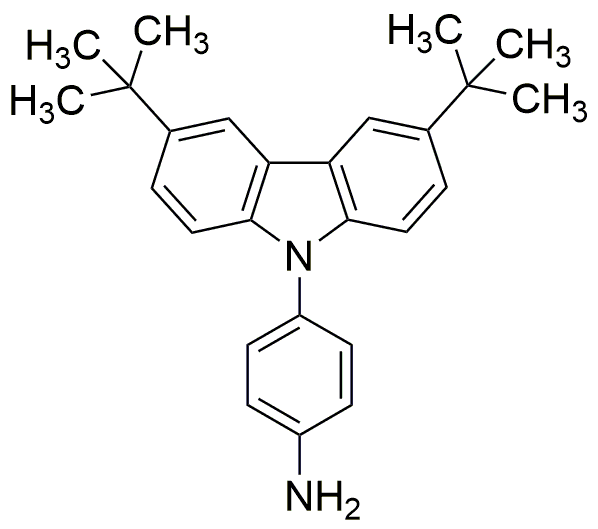4-(3,6-Di-tert-butyl-9H-carbazol-9-yl)aniline is widely utilized in research focused on:
- Organic Electronics: This compound is used in the development of organic light-emitting diodes (OLEDs), enhancing the efficiency and brightness of displays in smartphones and televisions.
- Photovoltaic Cells: It serves as a key material in organic solar cells, contributing to improved energy conversion efficiency, making solar energy more accessible and affordable.
- Fluorescent Dyes: The compound is employed in creating fluorescent probes for biological imaging, aiding researchers in visualizing cellular processes with high precision.
- Polymer Science: It is incorporated into polymer matrices to improve thermal stability and mechanical properties, benefiting industries that require durable materials.
- Pharmaceutical Research: The compound's unique properties make it a candidate for drug development, particularly in targeting specific cellular pathways, offering potential advancements in treatment options.
General Information
Properties
Safety and Regulations
Applications
4-(3,6-Di-tert-butyl-9H-carbazol-9-yl)aniline is widely utilized in research focused on:
- Organic Electronics: This compound is used in the development of organic light-emitting diodes (OLEDs), enhancing the efficiency and brightness of displays in smartphones and televisions.
- Photovoltaic Cells: It serves as a key material in organic solar cells, contributing to improved energy conversion efficiency, making solar energy more accessible and affordable.
- Fluorescent Dyes: The compound is employed in creating fluorescent probes for biological imaging, aiding researchers in visualizing cellular processes with high precision.
- Polymer Science: It is incorporated into polymer matrices to improve thermal stability and mechanical properties, benefiting industries that require durable materials.
- Pharmaceutical Research: The compound's unique properties make it a candidate for drug development, particularly in targeting specific cellular pathways, offering potential advancements in treatment options.
Documents
Safety Data Sheets (SDS)
The SDS provides comprehensive safety information on handling, storage, and disposal of the product.
Product Specification (PS)
The PS provides a comprehensive breakdown of the product’s properties, including chemical composition, physical state, purity, and storage requirements. It also details acceptable quality ranges and the product's intended applications.
Certificates of Analysis (COA)
Search for Certificates of Analysis (COA) by entering the products Lot Number. Lot and Batch Numbers can be found on a product’s label following the words ‘Lot’ or ‘Batch’.
*Catalog Number
*Lot Number
Certificates Of Origin (COO)
This COO confirms the country where the product was manufactured, and also details the materials and components used in it and whether it is derived from natural, synthetic, or other specific sources. This certificate may be required for customs, trade, and regulatory compliance.
*Catalog Number
*Lot Number
Safety Data Sheets (SDS)
The SDS provides comprehensive safety information on handling, storage, and disposal of the product.
DownloadProduct Specification (PS)
The PS provides a comprehensive breakdown of the product’s properties, including chemical composition, physical state, purity, and storage requirements. It also details acceptable quality ranges and the product's intended applications.
DownloadCertificates of Analysis (COA)
Search for Certificates of Analysis (COA) by entering the products Lot Number. Lot and Batch Numbers can be found on a product’s label following the words ‘Lot’ or ‘Batch’.
*Catalog Number
*Lot Number
Certificates Of Origin (COO)
This COO confirms the country where the product was manufactured, and also details the materials and components used in it and whether it is derived from natural, synthetic, or other specific sources. This certificate may be required for customs, trade, and regulatory compliance.


